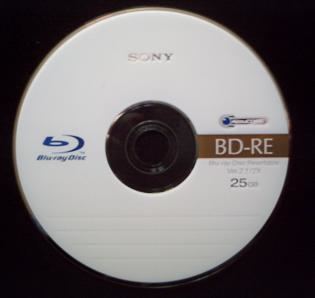 | ||
Blu-ray Disc Recordable (or BD-R) refers to two direct to disc optical disc recording technologies that can be recorded on to an optical disc with an optical disc recorder. BD-R discs can be written to once, whereas BD-RE (Blu-ray Disc Recordable Erasable) can be erased and re-recorded multiple times. Disc capacities are 25 GB for single-layer discs, 50 GB for double-layer discs, 100 GB for triple-layer, and 128 GB for quadruple-layer (in BD-R only).
Contents
- Version
- Version 10RE 10
- Version 20RE 20
- Version 30RE 30
- Version 40RE 40BDXL
- Version 10R 10
- Version 20R 20
- Version 30R 30 BDXL
- Speed
- Pricing
- BD R LTH low to high
- References
The minimum speed at which a Blu-ray Disc can be written is 36 megabits (4.5 megabytes) per second.
Version
There are four versions of Blu-ray Disc Recordable Erasable (BD-RE) and three versions of Blu-ray Disc Recordable (BD-R). Each version includes three Parts (a.k.a. Books): Basic Format Specifications, File System Specifications, Audio Visual Basic Specifications. Each part has sub-versions (e.g. R2 Format Specification includes Part 3: Audio Visual Basic Specifications Ver.3.02, Part 2: File System Specifications Ver. 1.11, Part 1: Basic Format Specifications Ver. 1.3).
Version 1.0—RE 1.0
Version 2.0—RE 2.0
Version 3.0—RE 3.0
Version 4.0—RE 4.0—(BDXL)
Version 1.0—R 1.0
Version 2.0—R 2.0
Version 3.0—R 3.0 (BDXL)
Speed
Note: Add extra time for disc verification phase and time for erasing the disc in the case of BD-RE.
Pricing
As of July 2013 (approximate pricing)
As of February 2014 (approximate pricing)
As of February 2014 (approximate pricing)
As of November 2016 (approximate pricing)
BD-R LTH (low to high)
BD-R LTH is a write-once Blu-ray Disc format that features an organic dye recording layer. "Low To High" refers to the reflectivity changing from low to high during the burning process, which is the opposite of normal. The advantage of BD-R LTH is it can protect a manufacturer's investment in DVD-R/CD-R manufacturing equipment. The manufacturer need only modify current equipment; it need not invest in new production lines. This is expected to lower the cost of disc manufacturing.
Old Blu-ray players and recorders cannot utilize BD-R LTH; however, a firmware upgrade can enable devices to access BD-R LTH. Panasonic released such a firmware update in November 2007 for its DMR-BW200, DMR-BR100 and MR-BW900/BW800/BW700 models. Pioneer was expected to ship the first LTH BD drives in Spring 2008. Sony upgraded the PlayStation 3 firmware enabling BD-R LTH reading in March, 2008.
In 2011, France's Ministry of Culture and Communication conducted a study on the suitability of data archival of LTH (low to high) discs compared to HTL (high to low) discs. The data they collected indicated that the overall quality of LTH discs is worse than HTL discs.
